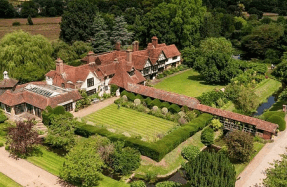he elder tree takes the Anglo-Saxon name , fire, the hollow stems with pith removed being used to blow into the centre of fires to generate heat. Its, is linked to a medieval wind instrument, the sackbut, which was fashioned from elder wood. The tree was revered. It was sacred to the Druids, who believed the Earth Mother lived within it; in the Celtic tree calendar, November 25–December 21 saw the Elder Moon. Elder wine was drunk to stimulate clairvoyance and hallucination. The tree maintained its magical properties through the Middle Ages. Planted close to homes, it repelled the devil and witches, so boughs were placed in doorways and twigs were carried for that purpose. Rural folk carried dried leaves around their neck or that of an animal, casting them into graves to protect the souls of the deceased. The shrub variety was believed to grow only where battles with Vikings had been fought, its folk names including daneswort.
Keeping it real: elder (Sambu-cus nigra) and ivy (Hedera helix)
Dec 06, 2023
1 minute
You’re reading a preview, subscribe to read more.
Start your free 30 days



